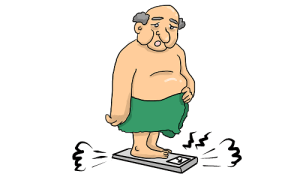Weight loss surgery, or bariatric surgery, can help you safely and effectively lose weight when obesity has become a problem and diet and exercise fail to lower the number on the scale.

Bariatric surgery helps you lose weight in the following ways:
Weight loss surgey can help facilitate weight loss in two ways – restricting diet and helping malabsorption. By shrinking the size of your stomach, weight loss surgery will help you eat less food and become fuller faster. By bypassing a portion of the bowel, bariatrics helps your body absorb less calories, further contributing to your weight loss.
There are four primary types of weight loss surgery you can choose from. Ask your bariatric surgeon if any sound ideal for your situation.
1- Lap Band
A laparoscopic adjustable gastric banding procedure (lap band) involves your surgeon placing an adjustable band around your stomach, which limits the available space for food. The resulting stomach pouch above the band will then have a narrow opening leading to the rest of the stomach.
Patients undergoing the lap band procedure get a port that is placed under the skin on the abdomen. A tube will connect the port to the band. Your bariatric surgeon will inject or remove fluid through the port, whereby the balloon can be inflated and deflated to adjust the band’s size.
Gastric banding helps you lose weight by restricting the amount of food your stomach holds, helping you feel fuller much sooner than before.
2- Gastric Bypass
Roux-en-Y gastric bypass involves the bariatric surgeon creating a small pouch at the top of the stomach. That pouch is where you will hold food, which limits the amount that you can comfortably drink and eat at one time.
The small intestine is subsequently connected to the new pouch, which directs food from your stomach to your intestine. The primary part of the stomach continues to create digestive juices.
The portion of the intestine that is still attached to the main stomach will be reattached further down. This allows the digestive juices to flow directly into the small intestine.
Since food is now bypassing a portion of the small intestine, you end up absorbing fewer calories and nutrients.
3- Gastric Balloon
A gastric balloon is an outpatient procedure that involves inserting and inflating a small silicone balloon in a portion of your stomach. This leaves less room available for the food you eat, which limits your food intake. After six months, the balloon can be removed, which leaves your stomach operating just the way it was before the procedure.
By that time, you will have grown used to recognizing the signals that regulate hunger and satiety in the brain and body. You will also have established healthier eating and exercising habits, which are critical to supporting a healthier lifestyle.
4- Gastric Sleeve
A laparoscopic gastric sleeve (sleeve gastrectomy) involves removing a portion of your stomach, which leaves a tube-like section behind. The smaller pouch left for food limits the number of calories you consume.
The surgery also causes your body to produce less of the hormone that regulates hunger, called ghrelin, which reduces your desire to eat. Not only do you eat less with a gastric sleeve, but you won’t feel any nagging hunger, helping you lose weight comfortably.
Out of all the weight loss procedures we offer, we recommend the gastric sleeve the most to patients who are qualified. Find out if you are a candidate for bariatric surgery by calling.
What is the Difference Between Lap Band Surgery and Gastric Sleeve?
Many patients are torn between the lap band and gastric sleeve. Both procedures restrict the amount of food and nutrients that are absorbed by the body. The way the procedures accomplish this is what sets them apart.
The lap band is an implement that wraps around the stomach. When the band is cinched shut, there will only be limited space available to hold food. The band can then be adjusted with saline injections using the port placed into the abdomen and just under the skin. There is no cutting or stapling involved with a lap band, and you will digest food normally.
With the gastric sleeve, the surgeon does cut the stomach and effectively removes around three-fourths of the tissue. The remaining portion is in the shape of a tube, or sleeve. Your hunger hormones are also affected, helping you feel less hungry.
Since the sleeve gastrectomy procedure involves cutting and suturing the stomach, some recovery time is necessary. Recovery is also significantly longer than the lap band.
However, while the gastric sleeve is more invasive than the lap band, the procedure has shown to produce the greatest amount of weight loss in the first year to year and a half following surgery.
What are the Long-Term Side Effects of Gastric Sleeve?
The most significant effect of gastric sleeve is fast weight loss. You can expect to drop up to 70% of your excess weight within one year of surgery. However, sleeve gastrectomy can also reduce your risk of quite a few health problems, including gastroesophageal reflux disease, high blood pressure, type 2 diabetes, stroke, and obstructive sleep apnea, just to name a few.
There are some side effects that can occur, though they are rare. You may experience excessive bleeding, adverse reactions to anesthesia, blood clots, infection, and lung or breathing problems.
Over the long term, you could also develop a gastrointestinal obstruction, low blood pressure, malnutrition, vomiting, and hernias.
If you develop any of these symptoms after gastric sleeve or experience leakage from the cut edge of the stomach, tell your bariatric surgeon immediately so that steps can be taken to correct them.
Can You Regain Weight After Gastric Sleeve?
Gastric sleeve surgery is designed to promote long-term weight loss for life. However, in about 30% of patients, revision surgery is needed. Gaining some of the weight back is a common reason for revision surgery.
What is the Success Rate of Gastric Sleeve Surgery?
The rate of success for the gastric sleeve is incredibly high for several important reasons. For one, the procedure is safe with a low probability of complications. However, complications can occur, which is why you must follow your bariatric surgeon’s recommendations for adopting healthier living habits before, during, and after surgery.
How Much Weight Will I Lose with the Gastric Sleeve Procedure?

What Happens if You Eat Too Much After Gastric Sleeve?
Following the sleeve gastrectomy procedure, your food pouch is small and will only hold around a cup and a half of food.
If you do happen to overeat, you can begin to feel very sick. Side effects of overeating after gastric sleeve include vomiting and diarrhea. Your stomach can also stretch, making the bariatric surgery futile. Finally, you may experience an effect known as plugging, where food becomes stuck in the upper digestive tract or pouch.

Can You Eat Rice After Gastric Sleeve?
Since you only have so much room for available food with a gastric sleeve, there are some foods your bariatric surgeon will tell you to avoid. These are mostly foods that offer little nutritional value, like sweets and high-fat foods.
Other foods, rice, in particular, should be avoided because it can form a paste in your throat that is difficult to swallow without liquid. In rare cases, rice can block the stoma, which is the pouch that represents your new stomach. Pasta and bread can lead to a similar effect.
Can You Drink Soda After a Gastric Sleeve?
When it comes to sugary and caffeinated drinks, like soda, you may want to say no after gastric sleeve. The carbonation in soda can cause you to feel bloated. Usually, you could just burp to relieve this pressure. However, since your stomach has been altered because of the gastric sleeve, the bloating can cause severe discomfort. You may also put pressure on the incision, causing even more severe issues down the line. In addition, sodas and some fruit juices can lead to dumping syndrome, which is a condition that develops after surgery where sugar and other food moves to your small bowel too quickly. The result is abdominal cramping, diarrhea, and general discomfort that can last up to three hours after eating.
While there are some guidelines you must follow to recover properly from the gastric sleeve, and healthy lifestyle habits you need to adopt, you can safely lose weight with this fantastic and life-changing bariatric procedure.
To learn more about the gastric sleeve, contact Dr. Moein at Healthy Life Bariatrics. CaLL now to schedule.

